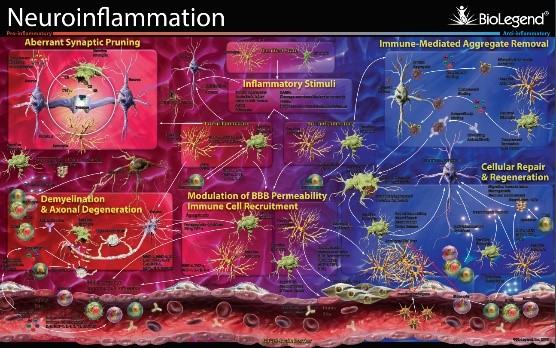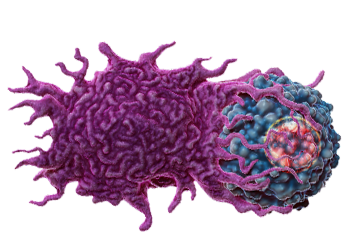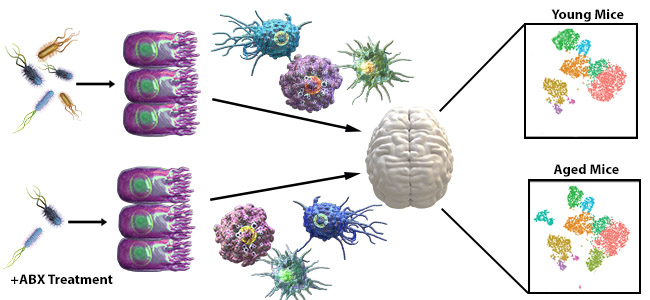Single-Cell Multiomics Reveals the Neuroimmune Landscape
Immune cells reside in the central nervous system (CNS) and are involved in the development and maintenance of homeostasis. These cells also respond to harmful stimuli and are part of neuroinflammation, a complex biological response that is a prominent feature of many neurological diseases. Despite the prominent role of these cells, our full understanding of the immune landscape in the brain, including cellular plasticity and heterogeneity, is incomplete.
To gain new insights into the immune landscape in the brain, researchers are using single-cell multiomics applications, like CITE-seq, to pair immunophenotyping with the transcriptional state of the cell. Our TotalSeq™ oligo-conjugated antibodies empower protein detection by sequencing and our pre-titrated antibody panels allow for ultra-high parameter immunophenotyping with the detection of 130+ markers.
Discover TotalSeq™ antibody panels.
Explore the ways scientists are using our multiomics reagents to understand the role of immune cells in glioblastoma and determine how aging and gut microbiota influence cell plasticity.

Learn more about how immune cells function in Neuroinflammation by downloading or requesting our poster.
Profiling of Myeloid Cells in Glioblastoma
Glioblastomas (GBMs) are aggressive tumors that typically have a poor prognosis. Following treatment, they often recur and are resistant to therapy 1. The GBM immune landscape includes both macrophages and dendritic cells (DCs). To determine the role of these cells in GBM and whether they contribute to therapy resistance, Pombo Antunes et al. used CITE-seq to profile myeloid cells both within mouse tumors and in its border regions2. In this Nature Neuroscience article, they identified and profiled five main DC subsets—cDC1, cDC2, MigDC, pre-DC, and pDCs.

Understand dendritic cell and macrophage development and find cell markers to study them.
The authors also studied the origin of the tumor-associated macrophages. They found the macrophages were either microglia- or bone marrow monocyte-derived, and these two ontogenies compete within the tumor. Interestingly, in recurrent tumors, the authors found that the ontogeny of the cells switched suggesting that treatment may alter the tumor microenvironment.
These studies reveal the complexity of myeloid cells associated with glioblastoma. A complete understanding of this complexity allows us to develop targets for these specific populations and determine the cause of therapy resistance.
Discerning Immune Cell Plasticity During Aging and Microbiota Dysbiosis
Dysregulation of immune cells in the brain causes changes in homeostasis that can lead to neurodegenerative diseases and neuroinflammation. The plasticity and function of these immune cells in the brain are influenced by the tissue microenvironment. External factors like aging and gut microbiota contribute to inflammation and communicate with immune cells, including those in the CNS. To better understand how these cells are influenced by external factors, Golomb et al. performed CITE-seq to map brain cell plasticity following systemic perturbations, including aging and gut dysbiosis3. For these experiments, they used mice that had been aged and/or treated with antibiotics to induce gut dysbiosis.

Using CITE-seq, the authors determined how external factors influenced CNS immune cell plasticity.
Modified from Golomb et al.
In these experiments, the authors found that the microglia and border-associated macrophages retained a relatively stable transcriptome while monocytes and ILCs were more plastic. In the aging brain, the authors found that Ly6C+ monocytes exhibited a pro-inflammatory signature, and ILCs developed an ILC2-like phenotype. Overall, aging and, to a lesser extent, gut dysbiosis push CNS-resident immune cells towards a pro-inflammatory state. By building a comprehensive map of these cells, additional studies can determine the exact mechanisms by which external factors influence neuroimmune cells.
Single-Cell Multiomics Solutions
Dysregulation of immune cell function in the brain is associated with neuroinflammation and neurodegenerative diseases. See how our scientists used TotalSeq™ reagents for proteomic analysis of microglia during acute neuroinflammation.
Our TotalSeq™ reagents include hundreds of antibodies for markers associated with immune cells and contain additional antibodies for neuroscience targets, like microglial markers. Accelerate your neuroscience research with high-parameter immunophenotyping using single-cell multiomics.
References
- Omuro A, DeAngelis LM. Glioblastoma and other malignant gliomas: a clinical review. JAMA 310(17):1842-50 (2013).
- Pombo Antunes, A.R., Scheyltjens, I., Lodi, F. et al. Single-cell profiling of myeloid cells in glioblastoma across species and disease stage reveals macrophage competition and specialization. Nat Neurosci 24, 595–610 (2021).
- Golomb, et al. Multi-modal Single-Cell Analysis Reveals Brain Immune Landscape Plasticity during Aging and Gut Microbiota Dysbiosis. Cell Reports 33(9): 108438 (2020).
 Login / Register
Login / Register 






Follow Us